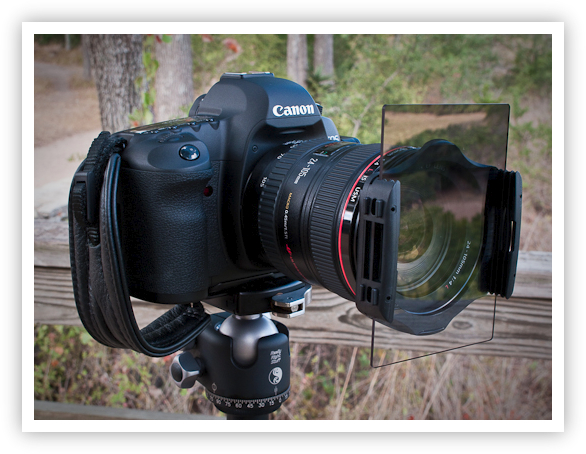By now, everyone knows I'm an old-fashioned kind of guy when it comes to getting the correct exposure "in-camera" as opposed to "in post". For me post capture processing in Lightroom or Photoshop is a matter of tweaking a RAW image to obtain what I remembered seeing when I took the shot. I've also fallen out of love with using HDR for landscape photography as I tend to think it interferes with the story the picture is telling rather than enhancing that story.
Since many of you reading this blog are relatively new to photography and perhaps to the use of filters, I thought I'd explain my basic setup for the Summer Nights shot I posted a few days ago. This also gives me a chance to showoff an image taken with my new Canon Powershot G10 P&S camera. BTW - I was amazed by the image quality this little camera can produce at low ISO speeds.

Singh-Ray Neutral Density Grad Filter in Cokin "P" Series Holder
Copyright 2009 Jeff Lynch Photography
Shot taken with a Canon G10 set on aperture priority (Av). The exposure was taken at 14mm, f/5.6 for 1/30th of a second at ISO 80 on Lexar Professional digital film. Post capture processing was done in Lightroom 2. Click on the image above for a larger version.
This is my typical setup for a landscape shot with my 5DII on a lightweight but sturdy tripod (Gitzo Traveller using an RRS ball-head) and a Singh-Ray graduated neutral density filter held in place by a Cokin "P-Series" holder, mounted on a wide angle lens. The graduated neutral density filter is generally a 2, 3 or 4-stop / soft ND grad made by Singh-Ray, a company that designs and builds the best quality photographic filters in the world.
The purpose of the "ND Grad" filter is to "hold back" the bright sky to balance foreground exposure as shown in this early evening sunset shot below. This allows your DSLR to meter for the mid-tones without blowing out the bright highlights in the sky. The great thing about a graduated neutral density filter is that you, the photographer, have complete control over how much light the filter blocks by changing its position in the filter holder. Many photographers (myself included) prefer to hold the filter against the lens by hand, moving it to achieve exactly the effect we want.
On of my favorite landscape photographers (besides Bill Neill and John O'Connor) Steve Kossack, is famous for teaching students "conscious control over colors and light" and a big part of his craft is in using the right filter at the right time. Steve's also famous for hand-holding and moving his ND-Grad filters during the exposure so that each image is unique and one of a kind.
Getting control of the colors and the light "in-camera" using a graduated neutral density is a great way to extend your success and bring some control to your landscape photography.

Summer Nights
Copyright 2009 Jeff Lynch Photography
Shot taken with a Canon EOS 40D set on aperture priority (Av) using an EF 24-105mm f/4 L IS USM tripod mounted. The exposure was taken at 47mm, f/13 for 1/15th of a second at ISO 100 on Sandisk digital film using a Singh-Ray 2-Stop/Soft graduated neutral density filter. Post capture processing was done in Lightroom 2 and Photoshop CS4. Click on the image above for a larger version.
Posted in Photography Tagged: Canon, Canon 40D, Graduated Neutral Density Filter, Landscape Photography, Photography, Singh-Ray Filters
![]()
No comments:
Post a Comment